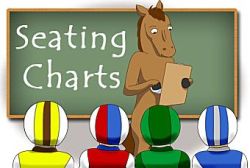by Bob Carson
Editor’s Note: The USTA Web site is pleased to present freelance writer Bob Carson and his popular “Outside the Box” features. This monthly series is a menu of outlandish proposals presented with a wink — but the purpose behind them is serious.
The pure and simple truth is rarely pure and never simple.” — Oscar Wilde
If there is a 50-50 chance that something can go wrong, then 9 times out of 10 it will.” — Paul Harvey

Bob Carson
Statistics are often misleading, always tricky and occasionally confusing — but the UDR (universal driver rating) is a statistic that does not hold absolute reliability.
The UDR number given to harness drivers to assess performance is not, as people have said countless times, “comparable to a baseball player’s batting average.” Not unless a few select baseball players get to choose lesser pitchers to hurl easy pitches over the middle of the plate every day. The system used to hook up drivers with harness horses is in need of revision.
This proposed system would determine which drivers are truly the best. It would also increase the odds for handicappers, remove some potential integrity issues, add another layer of intrigue to a harness horse race, and open the seats on sulkies to new drivers.
Here is the plan:
Race number one on the program is a trot for non-winners of $500 in the last six starts. There are eight trotters; post positions are drawn as usual. What is unusual is that none of the horses are assigned a driver. Listed on the program is the pool of eight drivers for this race. Not until the betting windows are locked will each of the eight drivers be randomly assigned the horse they will be driving.

Autumn Schmidt graphic
Imagine you are a bettor, owner or trainer under this system. The random draw moments before the race is an additional layer of excitement as you cross your fingers that a John Campbell or Tim Tetrick is selected. Addition excitement and drama are good. We need them in the harness game.
Of course the leading drivers will resent losing the opportunity to drive the best horses. The leading drivers of this era will moan that they have earned their place at the top of the heap. They are correct. The implementation of this revised system will have a few bruised feelings. So what? Things change in sports; think designated hitter, relief pitchers or the forward pass in football.
Under this system, the best driver in the race may get the worst horse in the race. This is good for the game. It would level the field and make the payoffs larger. Small time trainers and stables would have a shot at great drivers. It would also rev up the competitive juices of drivers in what can become a somewhat monotonous cycle. For the driver that is more sportsman than businessman, the test would be truer. Under this new system, at the end of the season your UDR would mean something — it would mean you got the best out of your drives, not that you drove the best horses.
The top drivers may well turn out to be the names we are familiar with but the UDR will soon be a much fairer and meaningful number. The drivers that rise to the top would still get perks, the better drivers would be assured placement in more races for higher purses — a true hierarchy.
Perhaps a harness race program with 14 races would have eight races (the most lucrative purses) for the “A” drivers (drivers with highest and more meaningful UDRs). Four races would have pools of “B” drivers and two races would have “C” drivers. (If not enough “C” drivers are available, “B” and “C” could be commingled).
Also, just like golf professionals, you cannot stay on the top tier by sheer reputation and momentum. A year of poor performance will find you dropping down the ladder — and opening up opportunities for others.
Would this new concept improve harness racing? Maybe. It would certainly be NEW and add an additional level of drama to each race, another dash of entertainment as the drivers are assigned seats. Cost should be nil. Implementation would be easy. And of course, people saying this is a bad idea will be plentiful.
However, if I were a young driver wishing to enter the sport, or a new owner, or a new trainer hoping to get a great driver to drive my horse, or a handicapper that likes the horse but is not sure of the driver, this random and democratic selection procedure would be attractive.
